Gynecomastia Surgery
Gynaecomastia is an increase in male breast tissue and fat. At the age of hormonal transformation, this maldevelopment often manifests itself. In most cases, gynaecomastia disappears on its own in adolescents.The growth of breast tissue in adolescents is often associated with excessive weight gain. An increase in oestrogen levels could be responsible for this. In men, this scenario can occur again when they become sexually mature. Gynaecomastia can also be triggered by taking certain medications and systemic diseases.
With a thorough physical examination and history, it plays an important role in the diagnosis of gynaecomastia. Adults with gynaecomastia who have had it for a long time and for whom other physical examination results are normal do not need additional medical examinations.
Surgical intervention may be required in patients whose gynaecomastia has been present for more than one year. The same rules apply if gynaecomastia persists for more than a year after an underlying cause has been treated.
Gynaecomastia is responsible for 65% of male breast disease.
Causes of gynaecomastia (man boobs)
Hormonal disorders that occur during puberty
Excessive alcohol use and drug abuse.
There may also be genetic factors involved.
This phenomenon, which occurs during adolescence, can lead to psychological problems in young men, manifesting as social withdrawal and introversion. However, it is a clinical picture that can be treated with today's aesthetic surgery procedures with a very high success rate.
Methods for the gynaecomastia treatment
Gynaecomastia is easily treated by liposuction or ultrasound liposuction, which reduces the growth of fatty tissue in the breast.
Surgical approach: Surgical removal of the extra tissue is preferred if glandular tissue rather than fatty tissue is the cause of the breast enlargement. Depending on the procedure, either a local or general anaesthetic is used. No hospital stay is required and the procedure takes only 30 to 90 minutes. Within three days, the patient resumes normal activities.
